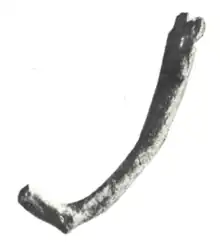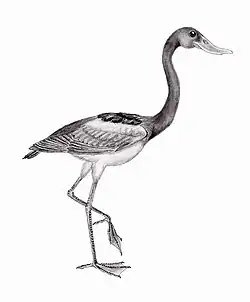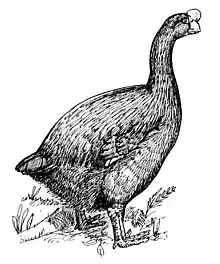Manu antiquus
Manu antiquus is a species of extinct bird of uncertain affinities from the Oligocene of New Zealand. It was described by Brian Marples in 1946 from fossil material (part of a furcula) found near Duntroon, north Otago, in the South Island. Marples suggested that it might be an early albatross; subsequent researchers have speculated that it could be a pelagornithid; however, its affinities remain uncertain. The genus name Manu is Māori for “bird”; the specific epithet antiquus is Latin for “old” or “ancient”.[2][3]
| Manu antiquus Temporal range: | |
|---|---|
 | |
| Anterior view of the holotype furcula | |
| Scientific classification | |
| Kingdom: | |
| Phylum: | |
| Class: | |
| Order: | |
| Family: | incertae familiae |
| Genus: | Manu |
| Species: | M. antiquus |
| Binomial name | |
| Manu antiquus Marples, 1946 | |
References
- Marples, B.J. (1946). "Notes on some neognathous bird bones from the Early Tertiary of New Zealand". Transactions of the Royal Society of New Zealand. 76: 132–134.
- Gill, B.J. (Convener, OSNZ Checklist Committee) (2010). Checklist of the Birds of New Zealand, Norfolk and Macquarie Islands, and the Ross Dependency, Antarctica. Fourth edition. Wellington: Te PaPa Press in association with the Ornithological Society of New Zealand. p. 333. ISBN 978-1-877385-59-9.
{{cite book}}: CS1 maint: multiple names: authors list (link) - Miskelly, C.M. (2013). "Bird of unknown affinities". New Zealand Birds Online. Retrieved 26 May 2014.
This article is issued from Wikipedia. The text is licensed under Creative Commons - Attribution - Sharealike. Additional terms may apply for the media files.


